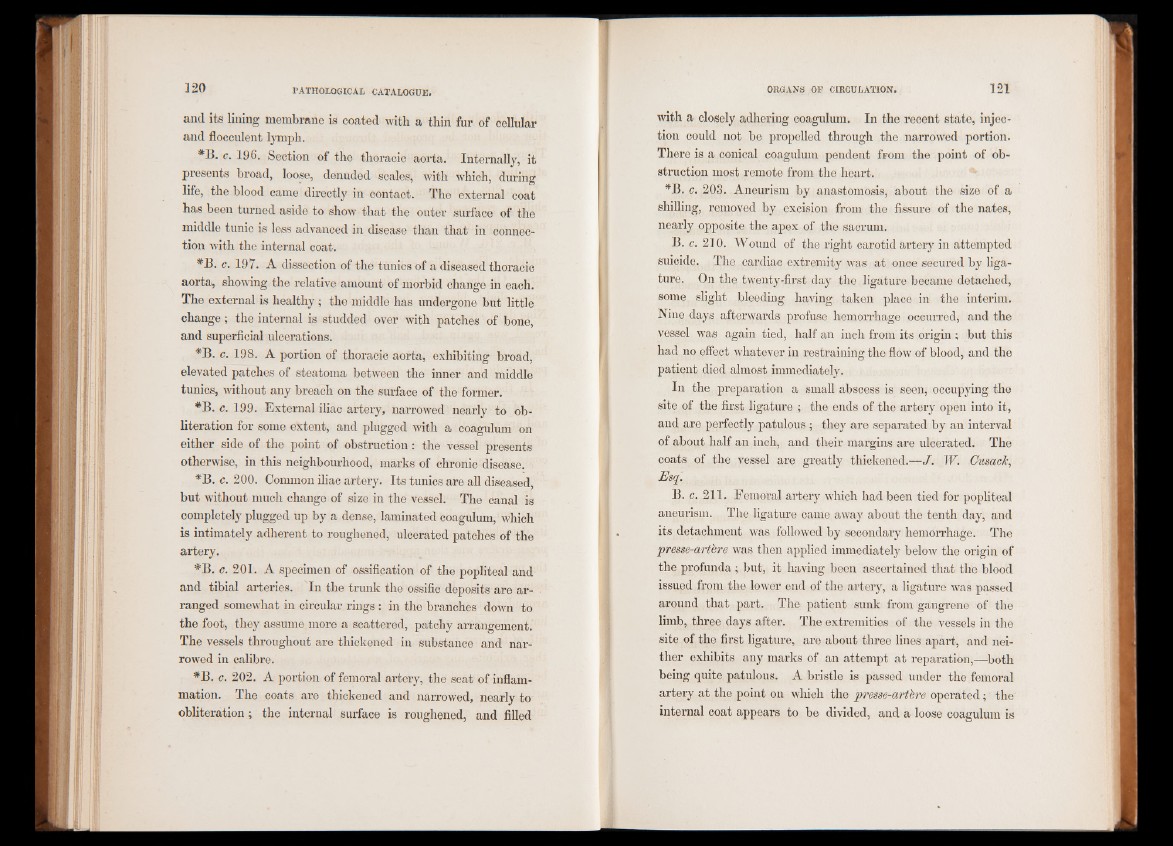
and its lining membrane is coated with a thin fur of cellular
and flocculent lymph.
#B. c. 196. Section of the thoracic aorta. Internally, it
presents broad, loose, denuded scales, with which, during
life, the blood came directly in contact. The external coat
has been turned aside to show that the outer surface of the
middle tunic is less advanced in disease than that in connection
with the internal coat.
#B. c. 197. A dissection of the tunics of a diseased thoracic
aorta, showing the relative amount of morbid change in each.
The external is healthy; the middle has undergone but little
change; the internal is studded over with patches of bone,
and superficial ulcerations.
*B. c. 198. A portion of thoracic aorta, exhibiting broad,
elevated patches of steatoma between the inner and middle
tunics, without any breach on the surface of the former.
#B. c. 199. External iliac artery, narrowed nearly to obliteration
for some extent, and plugged with a coagulum on
either side of the point of obstruction: the vessel presents
otherwise, in this neighbourhood, marks of chronic disease.
*B. c. 200. Common iliac artery. Its tunics are all diseased,
but without much change of size in the vessel. The canal is
completely plugged up by a dense, laminated coagulum, which
is intimately adherent to roughened, ulcerated patches of the
artery.
*B. c. 20 1 . A specimen of ossification of the popliteal and
and tibial arteries. In the trunk the ossific deposits are arranged
somewhat in circular rings : in the branches down to
the foot, they assume more a scattered, patchy arrangement.
The vessels throughout are thickened in substance and narrowed
in calibre.
#B. c. 202. A portion of femoral artery, the seat of inflammation.
The coats are thickened and narrowed, nearly to
obliteration; the internal surface is roughened, and filled
with a closely adhering coagulum. In the recent state, injection
could not be propelled through the narrowed portion.
There is a conical coagulum pendent fFom the point of obstruction
most remote from the heart.
*B. c. 203. Aneurism by anastomosis, about the size of a
shilling, removed by excision from the fissure of the nates,
nearly opposite the apex of the sacrum.
B. c. 210. Wound of the right carotid artery in attempted
suicide. The cardiac extremity was at once secured by ligature.
On the twenty-first day the ligature became detached,
some slight bleeding having taken place in the interim.
Nine days afterwards profuse hemorrhage occurred, and the
vessel was again tied, half an inch from its origin ; but this
had no effect whatever in restraining the flow of blood, and the
patient died almost immediately.
In the preparation a small abscess is seen, occupying the
site of the first ligature ; the ends of the artery open into it,
and are perfectly patulous ; they are separated by an interval
of about half an inch, and their margins are ulcerated. The
coats of the vessel are greatly thickened.—J. W. Cusack,
Esq.
B. c. 2 1 1 . Femoral artery which had been tied for popliteal
aneurism. The ligature came away about the tenth day, and
its detachment was followed by secondary hemorrhage. The
presse-artère was then applied immediately below the origin of
the profunda ; but, it having been ascertained that the blood
issued from the lower end of the artery, a ligature was passed
around that part. The patient sunk from gangrene of the
limb, three days after. The extremities of the vessels in the
site of the first ligature, are about three lines apart, and neither
exhibits any marks of an attempt at reparation,—both
being quite patulous. A bristle is passed under the femoral
artery at the point on which the presse-artère operated ; the
internal coat appears to be divided, and a loose coagulum is